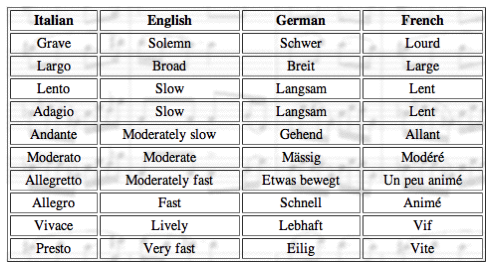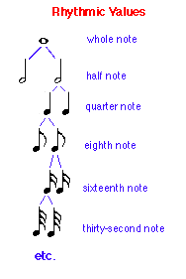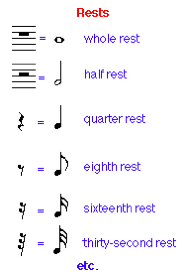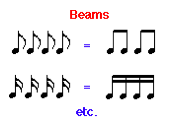 |
|
 |
 |
 |
 | Rhythm is a term we use to describe how music is placed in time. Rhythm can be expressed by notes with a pitch, like a piano, or notes without pitches, like a snare drum. Most music has rhythms that conform to a constant, even pulse. This pulse might be fast (over 4 pulses per second) or slow (less than one pulse per second). We often call this pulse the beat. (Note: if musicians play a passage very fast or very slow, it may sound like there are several pulses per beat or several beats per pulse. It is important to realize that the pulse is what you hear, the beat is what is notated).
Tempo is a term we use to describe the rate at which the beats are occuring. A composer generally indicates the tempo of a piece, movement, or section in one of two ways. The first we will mention here is the use of words, usually Italian. Below is a chart with most of the common tempo markings.
|
 |
 |
 |
 |
 |
 | The second method is much more precise. It indicates how many beats will occur in one minute's time. For example, if the desired tempo is to be 72 beats per minute with the quarter note getting one beat, the marking would be:

Rhythmic notation is how we specify where each note begins and ends in relation to the beat. Our modern system for notating rhythm has a very logical method of describing how long a note should sound. It uses a set of noteheads plus stems and flags to indicate duration. A whole note (see below) is accepted as a standard unit of measure. If it is equally divided into two parts, each of these is called a half note. A half note divided into two equal parts yields two quarter notes, which are each one quarter of a whole note, hence their name. This process theoretically continues on as far as needed, however in most music, one rarely encounters a note beyond a 32nd note. The following chart shows how these notes relate to one another:
|
 |
 |
 |
 |
 |
 | Music also requires a method of notating silence. Silence is notated by a rest. Rests follow the same hierarchy as notes, as the following chart indicates:
|
 |
 |
 |
 |
 |
 | With the exception of the whole and half, rests are usually centered in the staff. With whole and half rests, there is an easy way to remember which is which: Whole rests (being larger and therefore "heavier") always hang down from the fourth line, and half rests (being smaller) always float above the third line.
When a group of notes with flags occur within one beat (or in vocal music within one word or syllable) they are beamed together, to make this grouping more apparent to the performer. The number of beams is equal to the number of flags normally found on the note, so a group of eighth notes has a single beam, a grouping of sixteenth notes has two beams, etc.
|
 |
 |
 |
 |
 |
 | There are two methods used to notate more complex values. The first is to use a tie to join two note values together into one, sustained value. A tie is a curved line connecting the insides of the two noteheads. Any two or more note values may be tied together into longer durations, provided a separate tie is used between each notehead.
|
 |
 |
 |
 |
 |
 |
A second method uses a dot following the notehead to indicate that the duration is equal to one and one-half times the note's normal value. So for example, a dotted quarter note equals a duration of one quarter plus one eighth note, or three eighth notes total duration. A second dot adds half of the dot's value.
|
 |
 |
 |
 |
 |
 |
A beat may be subdivided into any number of equal divisions. When the number of subdivisions does not equal one of the standard subdivisions listed above, a tuplet must be used. A tuplet adds additional subdivisions to the normal amount that would be expected for the rhythmic value employed. If we wish to have three subdivisions of a quarter note, (instead of the normal two eighth notes) we can use a triplet (a three-note tuplet) to accomplish this.
|
 |
 |
|


 |
 |
 |




